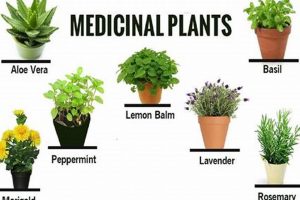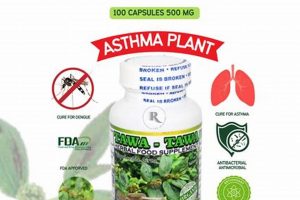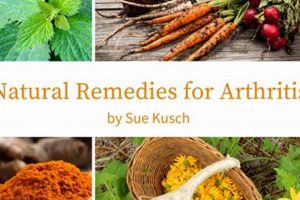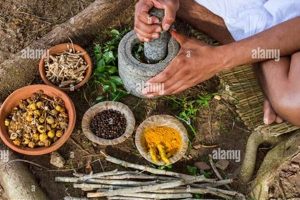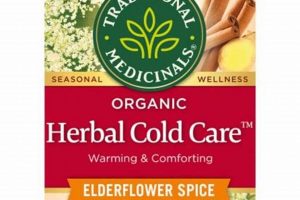Natural remedies derived from plants, utilized to alleviate elevated body temperature, have been employed across various cultures for centuries. These preparations often involve extracting specific compounds from plants known for their therapeutic properties and administering them in various forms such as teas, tinctures, or capsules. Examples include preparations using willow bark, known for its salicylic acid content, and elderflower, traditionally used to promote sweating.
The significance of phytotherapeutic approaches to managing pyrexia lies in their potential accessibility and affordability, particularly in regions with limited access to conventional medical care. Historical evidence suggests a long-standing reliance on botanical treatments, with traditional healers and apothecaries playing a crucial role in their provision. Furthermore, certain plant-based interventions may offer a gentler approach to symptom management, potentially minimizing the side effects associated with synthetic pharmaceuticals.
The subsequent sections will delve into specific botanical agents commonly considered for the reduction of elevated body temperature, examining their purported mechanisms of action, traditional uses, and available scientific evidence regarding their efficacy and safety. A discussion of potential risks, interactions, and considerations for responsible utilization will also be included.
Guidance on Utilizing Phytotherapeutic Agents for Pyrexia
The following recommendations are intended to provide informational guidance concerning the employment of botanicals in managing elevated body temperature. It is imperative to consult with a qualified healthcare professional before initiating any self-treatment regimen, particularly if underlying health conditions exist or conventional medications are being taken.
Tip 1: Identification of the Underlying Cause: Prior to initiating any form of treatment, including botanical interventions, it is crucial to determine the etiology of the pyrexia. Persistent or high-grade fevers may indicate a serious underlying condition requiring prompt medical attention. Self-treating without identifying the root cause is strongly discouraged.
Tip 2: Source Reputable Products: Ensure that any herbal preparations are obtained from reputable suppliers adhering to quality control standards. Look for products that have undergone third-party testing for purity and potency. Adulteration and contamination are significant concerns within the herbal medicine industry.
Tip 3: Adherence to Dosage Guidelines: Strictly follow recommended dosage guidelines provided by qualified herbalists or product labels. Exceeding recommended dosages can lead to adverse effects. Start with the lowest effective dose and gradually increase as needed, while carefully monitoring for any unwanted reactions.
Tip 4: Monitor for Allergic Reactions: Some individuals may experience allergic reactions to specific botanicals. Introduce new preparations cautiously and discontinue use immediately if any signs of an allergic reaction, such as rash, itching, or difficulty breathing, develop. Seek immediate medical attention if a severe allergic reaction occurs.
Tip 5: Be Aware of Potential Interactions: Herbal remedies can interact with conventional medications, potentially altering their effectiveness or increasing the risk of side effects. Disclose all herbal supplements being taken to a healthcare provider, particularly when taking prescription drugs.
Tip 6: Consider Traditional Preparations: Traditional methods of preparation, such as teas and infusions, may be gentler and more readily absorbed by the body. However, standardization of dosage can be challenging. Ensure proper brewing techniques are employed to maximize efficacy and minimize potential risks.
Tip 7: Recognize Limitations: Botanical interventions may be most effective for mild to moderate fevers. High-grade fevers, particularly those accompanied by other concerning symptoms, necessitate prompt evaluation and treatment by a medical professional. Reliance solely on natural remedies in such cases could delay appropriate care and potentially lead to adverse outcomes.
Adhering to these guidelines may facilitate the responsible and informed use of botanical agents in the management of pyrexia. However, it is crucial to reiterate that botanical remedies should not be considered a substitute for professional medical advice.
The following sections will further explore the scientific evidence and practical considerations associated with the utilization of botanical agents for addressing elevated body temperature.
1. Botanical Identification
The initial and fundamentally critical step in utilizing botanical agents for fever management resides in precise botanical identification. A misidentification can lead to the administration of an ineffective, or worse, a toxic plant, thereby jeopardizing patient safety and negating any potential therapeutic benefit. The presence or absence of specific chemical constituents that exhibit antipyretic properties is directly dictated by the plant species in question. For instance, mistaking Digitalis purpurea (foxglove), a cardiotoxic plant, for a seemingly similar, but harmless, plant could have severe consequences. Even within the same genus, different species can possess vastly different chemical profiles and pharmacological effects. Therefore, accurate identification by a trained botanist or herbalist is non-negotiable.
The importance of proper identification extends beyond simply avoiding toxicity. It ensures that the intended therapeutic compounds are actually present in the herbal preparation. Numerous factors can influence the chemical composition of a plant, including geographic location, growing conditions, and harvesting time. Knowing the precise species allows for the selection of plants known to consistently produce the desired levels of active constituents. Moreover, authentication methods, such as macroscopic and microscopic examination of plant parts, as well as chemical fingerprinting techniques (e.g., chromatography), provide further assurance of accurate identification. This is particularly relevant in the context of commercially available herbal products, where adulteration and substitution are unfortunately common issues. A real-world example is the substitution of Echinacea purpurea with less potent, or even ineffective, Echinacea species in some commercial preparations.
In summary, reliable botanical identification forms the cornerstone of safe and effective herbal fever management. It prevents potentially harmful exposures, guarantees the presence of desired therapeutic compounds, and facilitates the selection of plants with consistent chemical profiles. Addressing the challenges associated with botanical identification through rigorous training, authentication methods, and quality control measures is essential for the responsible and evidence-based use of botanical interventions in addressing elevated body temperature, linking directly to the broader theme of phytotherapeutic efficacy and patient safety.
2. Preparation Methods
The efficacy of botanical interventions targeting elevated body temperature is intrinsically linked to preparation methodologies. These methods directly influence the extraction and bioavailability of active compounds, thereby dictating the therapeutic potential of the final product. The choice of preparation significantly alters the chemical profile and, consequently, the pharmacological effects of the herbal remedy.
- Aqueous Extraction (Teas and Infusions)
Aqueous extraction, commonly employed in teas and infusions, involves steeping plant material in hot water to solubilize water-soluble compounds. This method is suitable for extracting volatile oils, flavonoids, and other polar constituents. For instance, peppermint tea, prepared through infusion, releases menthol, which may contribute to fever reduction via its cooling properties. However, less polar compounds may be poorly extracted using this method, limiting the overall therapeutic potential in some cases. Careful consideration must be given to steeping time and water temperature to optimize extraction without degrading heat-sensitive compounds.
- Alcoholic Extraction (Tinctures)
Alcoholic extraction, resulting in tinctures, utilizes alcohol as a solvent to extract a broader range of compounds, including resins and alkaloids, which may not be readily soluble in water. Tinctures generally exhibit a longer shelf life compared to aqueous preparations. The use of Echinacea tincture, for example, may provide a more concentrated dose of alkylamides, known for their potential immunostimulatory effects. However, the presence of alcohol may be a contraindication for certain individuals, and appropriate dilution is crucial.
- Decoction (Boiling Extracts)
Decoction involves boiling plant material, typically hardier parts like roots or bark, in water for an extended period. This method is suitable for extracting compounds from tougher plant tissues that may not be readily released through infusion. For instance, a decoction of willow bark extracts salicin, a precursor to salicylic acid. Prolonged boiling, however, can degrade volatile compounds and should be carefully controlled to prevent unwanted chemical alterations.
- Encapsulation (Powdered Herbs)
Encapsulation involves placing dried and powdered plant material into capsules for oral administration. This method offers convenience and allows for standardized dosages. However, the bioavailability of compounds from encapsulated herbs may be lower compared to liquid extracts due to slower absorption rates. Furthermore, the quality control of powdered herbs is critical to ensure accurate species identification and prevent adulteration. Encapsulated turmeric, for example, may contain varying levels of curcuminoids, affecting its potential anti-inflammatory effects.
The selection of an appropriate preparation method directly impacts the composition and therapeutic activity of the resulting product. Understanding the solubility characteristics of key compounds, considering potential contraindications, and implementing rigorous quality control measures are crucial for optimizing the utilization of botanical interventions in managing elevated body temperature. The proper preparation will provide the best approach for botanical efficacy.
3. Dosage Considerations
The therapeutic efficacy and safety of plant-derived interventions targeting pyrexia are fundamentally dependent upon dosage considerations. The administration of an insufficient dose may fail to elicit the desired antipyretic effect, whereas an excessive dose can precipitate adverse reactions, potentially counteracting the intended therapeutic benefit. Therefore, a thorough understanding of appropriate dosage parameters is crucial for responsible utilization of botanical agents. For example, the dosage of willow bark, used traditionally for its salicin content, must be carefully calibrated; insufficient amounts will not reduce fever, while excessive quantities may lead to gastrointestinal distress or, in rare cases, salicylate toxicity. Similarly, elderflower, often employed to promote sweating and potentially reduce fever, requires careful dose regulation, as excessive consumption can lead to dehydration and electrolyte imbalance.
The establishment of safe and effective dosage guidelines for botanical agents presents several challenges. Unlike conventional pharmaceuticals, the concentration of active constituents can vary significantly within different plant samples, depending on factors such as growing conditions, harvesting time, and processing methods. This variability necessitates a cautious approach to dosage determination, often relying on traditional knowledge, empirical observations, and, increasingly, scientifically derived data. Furthermore, individual factors such as age, weight, overall health status, and concurrent medication use can significantly influence the response to botanical interventions. For instance, a child requires a substantially lower dose of a given herbal remedy compared to an adult, and individuals with impaired liver or kidney function may exhibit altered drug metabolism, necessitating dosage adjustments. A real-world illustration of the importance of dosage considerations is the use of ginger for fever-related nausea; while small doses can alleviate nausea, excessive amounts may exacerbate gastrointestinal discomfort.
In conclusion, dosage considerations are an indispensable component of the judicious application of plant-based fever remedies. An informed approach, incorporating factors such as plant variability, individual patient characteristics, and potential drug interactions, is essential to maximize therapeutic benefit while minimizing the risk of adverse effects. The development of standardized herbal preparations with clearly defined dosages and comprehensive safety profiles remains a crucial objective for promoting the responsible and evidence-based integration of botanical agents into fever management strategies. Additionally, advocating for clear communication between patients and healthcare professionals regarding the use of herbal remedies is paramount to ensuring patient safety and optimizing treatment outcomes.
4. Safety Profiles
The safety profiles of plant-derived medicines used to alleviate elevated body temperature constitute a critical component of responsible and effective healthcare. Understanding potential risks, contraindications, and interactions associated with these botanicals is paramount to minimizing adverse events and ensuring patient well-being. An incomplete or inaccurate assessment of the safety profile can lead to unforeseen complications, particularly in vulnerable populations such as children, pregnant women, and individuals with pre-existing medical conditions. For example, certain botanical agents traditionally used to reduce fever may possess anticoagulant properties, posing a significant risk of bleeding complications in patients taking anticoagulant medications or those with bleeding disorders. Similarly, some herbs may interact with conventional pharmaceuticals, altering their metabolism or increasing the risk of side effects.
The evaluation of safety profiles necessitates a comprehensive approach, incorporating both traditional knowledge and contemporary scientific evidence. Traditional uses often provide valuable insights into potential adverse effects, based on centuries of empirical observation. However, such information should be critically evaluated in light of modern pharmacological understanding and rigorous scientific investigation. Preclinical studies, clinical trials, and post-market surveillance play crucial roles in characterizing the safety profiles of botanical interventions. These studies can identify potential toxicities, determine safe dosage ranges, and assess the likelihood of drug interactions. For instance, while elderflower is generally considered safe for short-term use, long-term studies are lacking, and potential interactions with immunosuppressant medications require further investigation. Furthermore, the quality control of herbal products is essential to ensuring safety, as adulteration with toxic substances or contamination with heavy metals can pose significant health risks.
In summary, a thorough understanding of the safety profiles of plant-based fever remedies is indispensable for their responsible and effective use. Integrating traditional knowledge with scientific evidence, adhering to quality control standards, and communicating potential risks to patients are crucial steps in minimizing adverse events and maximizing therapeutic benefit. The development of comprehensive safety databases and the promotion of collaborative research efforts are essential for advancing our understanding of the safety profiles of these agents and promoting their safe and effective integration into healthcare systems. A failure to address the safety aspect seriously may significantly reduce their effectiveness. A proactive safety plan is a must when considering plant-based fever remedies.
5. Efficacy Evidence
The purported benefits of plant-derived treatments for elevated body temperature necessitate rigorous evaluation of efficacy evidence. The historical prevalence of herbal remedies does not, on its own, constitute proof of effectiveness. A demonstrable cause-and-effect relationship between the administration of a specific botanical agent and a measurable reduction in fever is required to establish its therapeutic merit. The absence of robust efficacy evidence undermines the rationale for utilizing these remedies, potentially leading to ineffective treatment and delayed access to conventional medical care when necessary. For example, while anecdotal reports may suggest that chamomile tea reduces fever, controlled clinical trials are needed to determine whether this effect is statistically significant and clinically relevant. Without such evidence, the recommendation of chamomile tea remains speculative.
The evaluation of efficacy evidence for botanical treatments for fever involves a multi-faceted approach. Randomized controlled trials (RCTs) represent the gold standard for assessing therapeutic effectiveness. These trials compare the effects of the herbal remedy to a placebo or a conventional treatment, while controlling for confounding variables. Meta-analyses, which systematically combine the results of multiple RCTs, provide a more comprehensive assessment of efficacy. Furthermore, observational studies and case reports can offer preliminary evidence of potential benefits or risks, warranting further investigation through controlled trials. The practical significance of rigorous efficacy evaluation is exemplified by the case of willow bark. While traditional use suggested its antipyretic properties, it was the identification and isolation of salicin, followed by clinical trials demonstrating its effectiveness in reducing fever, that led to the development of aspirin, a widely used conventional medication.
In summary, the availability of robust efficacy evidence is an indispensable component of the responsible application of plant-derived remedies for elevated body temperature. Well-designed clinical trials, systematic reviews, and meta-analyses are crucial for determining whether these treatments offer genuine therapeutic benefits, outweighing potential risks. The challenges associated with evaluating efficacy evidence include the variability in plant composition, the potential for placebo effects, and the difficulty in blinding participants in studies involving herbal remedies. Addressing these challenges through rigorous methodological approaches is essential for promoting the evidence-based integration of botanical agents into fever management strategies. The demand for high-quality evidence is a demand for improved health outcomes.
Frequently Asked Questions
This section addresses common inquiries regarding the use of plant-derived remedies for the management of elevated body temperature. The information provided is intended for educational purposes and does not constitute medical advice. Consultation with a qualified healthcare professional is strongly recommended before initiating any self-treatment regimen.
Question 1: Are herbal medicines a safe alternative to conventional fever reducers?
The safety of herbal medicines for fever varies depending on the specific plant, preparation method, dosage, and individual patient factors. While some botanical agents may be relatively safe for short-term use in healthy individuals, others may pose significant risks, particularly in children, pregnant women, and individuals with pre-existing medical conditions. Conventional fever reducers, such as acetaminophen and ibuprofen, have well-established safety profiles when used as directed. A careful assessment of the risks and benefits is essential before opting for herbal remedies.
Question 2: How effective are herbal medicines in reducing fever?
The efficacy of herbal medicines for fever varies depending on the specific plant and the quality of the scientific evidence supporting its use. While some botanical agents have demonstrated antipyretic properties in clinical trials, others lack sufficient evidence to support their effectiveness. The variability in plant composition and preparation methods can also affect the consistency of results. Conventional fever reducers typically exhibit a more predictable and reliable effect.
Question 3: Can herbal medicines interact with conventional medications?
Yes, herbal medicines can interact with conventional medications, potentially altering their effectiveness or increasing the risk of side effects. Certain botanical agents can affect drug metabolism, absorption, or excretion, leading to unpredictable outcomes. It is crucial to disclose all herbal supplements being taken to a healthcare provider, particularly when using prescription drugs. Failure to do so can result in serious adverse events.
Question 4: How can one ensure the quality and purity of herbal medicines?
Ensuring the quality and purity of herbal medicines can be challenging, as the industry is not as tightly regulated as the pharmaceutical sector. Purchasing products from reputable suppliers who adhere to quality control standards is essential. Look for products that have undergone third-party testing for identity, purity, and potency. Avoid products with vague labeling or those that make unsubstantiated claims.
Question 5: Are there specific herbal medicines that are generally considered safe and effective for fever?
Some botanical agents, such as willow bark (containing salicin) and elderflower (used to promote sweating), have a long history of use for fever. However, even these remedies should be used with caution and under the guidance of a qualified healthcare professional. Individual responses to herbal medicines can vary, and potential risks must be carefully considered. Information regarding the specific herbs should be understood before administering to reduce fever.
Question 6: When should one seek conventional medical care for fever instead of relying on herbal medicines?
Conventional medical care should be sought for high-grade fevers (above 103F or 39.4C), fevers accompanied by severe symptoms (such as stiff neck, confusion, or difficulty breathing), or fevers that persist for more than a few days. Infants and young children with fever require prompt medical evaluation. Delaying appropriate medical care in favor of herbal remedies can have serious consequences.
In summary, the use of plant-derived treatments for elevated body temperature requires careful consideration of safety, efficacy, and potential interactions. While some botanical agents may offer potential benefits, they should not be considered a substitute for conventional medical care, particularly in cases of severe or persistent fever.
The subsequent sections will delve into the regulatory landscape surrounding plant-based therapeutics.
Conclusion
This exploration of herbal medicines for fever has illuminated the complexities inherent in their utilization. While possessing a rich history and cultural significance, these interventions demand a cautious and informed approach. Critical factors encompass accurate botanical identification, appropriate preparation methods, careful dosage considerations, thorough understanding of safety profiles, and rigorous evaluation of efficacy evidence. These elements are not discretionary; they are fundamental to responsible application.
The future of herbal medicines for fever necessitates a commitment to scientific rigor, standardized formulations, and transparent regulatory frameworks. Continued research is essential to elucidate mechanisms of action, assess long-term safety, and determine optimal integration with conventional medical practices. The responsible utilization of plant-derived remedies hinges on a dedication to evidence-based practice and a unwavering focus on patient well-being. The goal is to have the best health outcomes for people that are experiencing symptoms of fever.



